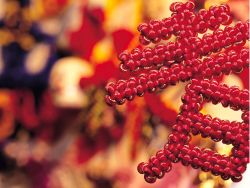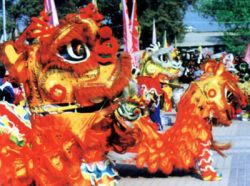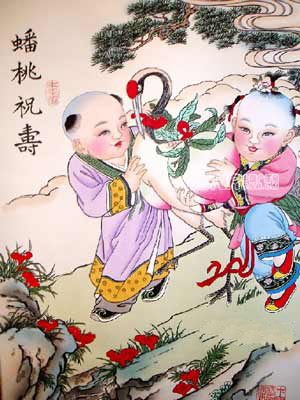Spring Festival
Spring Festival (春节) is the most important festival in China. It is the first day of the Lunar calendar and usually occurs somewhere between January 30 and February 20, heralding the beginning of spring, thus it is known as Spring Festival. This traditional festival is also a festival of reunion, just like Christmas in the West. No matter how far away people are from their homes, they will try their best to get back to have the Lunar New Year's Eve feast, also called the reunion dinner.
Contents
Origin
The Chinese meaning of this festival is Guo Nian. Guo means "pass over" and Nian means "year." The origin of the Chinese New Year Festival can be traced back thousands of years through a continually evolving series of colorful legends and traditions. According to one of the most famous legends, in ancient China there lived a horned monster named Nian who was extremely ferocious. Nian lived deep at the bottom of the sea all the year round and climbed up to the shore only on New Year's Eve to devour the cattle and kill people.
Thereupon on the day of every New Year's Eve people from all villages would flee, bringing along the old and the young, to the remote mountains so as to avoid the calamity caused by the monster Nian. Then, one New Year's Eve, the people of Peach Blossom village were getting ready to hide when there came from outside the village an old beggar with a stick in his hand and a bag hanging upon his arm. His eyes twinkled like stars and his beard was silver.
Seized with panic, the villagers were in a great hurry to run away. Some were closing the windows and locking the doors, some were packing, and others were urging the cattle and driving the sheep. At a time when the people were shouting and the horses were neighing no one was in the mood to care for the beggar.
Only a grandmother living in the east end of the village gave the old man some food and advised him to flee to the mountains to avoid the monster. But the old man stroked his beard and said with a smile, "If you allow me to stay at your home for the night, I'm sure to drive away the monster Nian."
The old woman was surprised to hear this. She looked at him unbelievingly only to find that, with white hair and ruddy complexion, the old man had a bearing out of the ordinary. She went on to persuade him to take flight. But he only smiled without reply. Thereupon the grandmother could not help but leave her home and flee to the mountains.
Around midnight the monster Nian rushed into the villages. He found the atmosphere was quite different from that of the previous year. The house of the grandmother in the east end of the village was brilliantly illuminated, with bright red paper stuck on the doors. Greatly shocked, the monster gave a strange loud cry.
The monster Nian stared angrily at the house for a moment then, howling furiously, made a charge at it. As he approached the door, there suddenly came the sounds of explosions. Trembling all over, the monster dared not take a step forward.
It turned out that the color red, flames, and explosions were what Nian feared the most. And when the door of the grandmother's house was thrown open and an old man in a red robe burst out laughing in the courtyard, the monster Nian was scared out of his wits and fled helter-skelter.
The next day was the 1st of the first lunar month. When people came back from their hideouts and found everything safe and sound, they were quite surprised. The old woman suddenly realized what had happened and told the villagers about the old beggar's promise.
The villagers swarmed into the grandmother's house, only to find that the doors were covered with red paper, the embers from a pile of bamboo were still giving out exploding sounds in the courtyard, and a few candles were still glowing in the room...
The story was soon spread far and wide and everybody was talking about it. They concluded in the end that the old beggar was surely the celestial being who came to expel the calamities and bless the people, and that red paper, red cloth, red candles, and the exploding firecracker were certainly the magic weapons to drive out the monster Nian.
To celebrate the arrival of such good luck, the elated villagers put on their clothes and new hats and went one after another to their relatives and friends to send their regards and congratulations. This was soon spread to the surrounding villages, and people all got to know the way to drive away the monster Nian.
From then on, on each New Year's Eve, each family sticks on their doors antithetical couplets written on red paper, blows up firecrackers, keeps their houses brilliantly illuminated and stays up late into the night. Early in the morning of the 1st of the first lunar month they go to their relatives and friends' homes to send their regards and congratulations. These customs have been passed down through the generations, making it the most ceremonious traditional festival of the Chinese people.
Custom
Lion Dance
The Lion Dance is one of the most popular dances in China. Known as the king of animals, the lion is a traditional symbol of good luck in China. The dance has a long history stretching back 2000 years. Records show that during the Tang Dynasty (618-907), the Lion Dance was already performed for the royal family.
In the Lion Dance, two people act as a lion; one moving the head and the other moving the body and tail; while one performer plays the part of the cub. The last dancer sways the silk ball with which the lion plays.
Skill is vital while any one of the many kinds of Lion Dance which continues to be one of the most popular forms of dance amongst acrobatics troupes today.
During the Lantern Festival and other festivals, the lion dance marks the beat of the frolics, bringing luck and happiness to all who contemplate it, if well-performed.
Styles of Lion Dance
The performances can be divided into Wenshi (civil lion) and Wushi (martial lion). Wenshi depicts a docile and amusing lion, playfully licking others and gently nodding off. Famous examples of this dance are the Luohan Playing with Lion in Sichuan and Hunan provinces and the Laughing Monk Playing with Lion in Shaanxi Province.
Opposed to his friendly cousin, Wushi portrays the power of the lion. Besides the athletic jumping and tumbling, performers show off their techniques by climbing upon a high table or by stepping across five wooden stakes. For instance, the Gaotai (High Terrace) Lion Dance of Sichuan Province is performed on seven high tables, increasing the difficulty. In recent years, the Lion Dance in Beijing melded different stylistic elements to become a new style.
Types by Geography
In over 1,000 years of development, the lion dance has developed into two major genres -- Northern Lion Dance and Southern Lion Dance.
The Northern Lion Dance has a longer history than all other forms of lion dance. It is said that in the Northern Wei Dynasty (386-534), Emperor Wudi launched an expedition to Hexi in Gansu Province, and captured over 100,000 Mongols. The emperor ordered the Mongols to dance for his entertainment. Over 30 Mongolian warriors held wooden carved animal heads, two large and five small, and clothed themselves animal skins, dancing before the emperor. The emperor was very pleased and named it Northern Wei Auspicious Lion, before allowing the captives to return home. The lion dance became popular across northern China, and the Northern Lion Dance was born.
The Northern Lion Dance mainly focuses martial lion performances such as the Auspicious Lion of the Northern Wei Dynasty. The small lion dance is performed by one person, while its larger counterpart is carried ou by two persons, with one person wielding the lion head while standing, and the other holding up the lion body and tail in a stooped position. Guided by the lion dancers, the lion writhes, falls forward, jumps and takes a bow, accompanied by higher-flying maneuvers, such as walking on wooden or bamboo stakes, jumping over a table, and stepping on a rolling ball.
There are several legends about the Southern Lion Dance in China. One of the legends surmises that in Qing Dynasty (1644-1911), Emperor Qianlong dreamed about the pilgrimage of an animal with bright fur on his inspection tour south of the lower reaches of the Yangtze River. After his return to Beijing, the emperor ordered his men to make a figure according to the image of the auspicious animal he dreamed about. He further ordered it to be paraded during festivals and ceremonies, to make the state prosperous and people peaceful.
The Southern Lion Dance mainly focuses on the civilized lion dance. The performance focuses on movements like scratching an itch, shaking the hair, preening itself and so on.
Nianhua
Nianhua (Spring Festival Picture) is a special type of painting in China. It is used during the Spring Festival.
It originated in the Pre-Qin Period (before 221 B.C.), a brief record of which can be found in Zhanguo Ce (Strategies of the Warring States Period).
As late as in the Western and Eastern Han Dynasties (206B. C. -220 A. D.), people liked to paste the images of various gods on both sides of the door, expecting them to ward off evil and usher in good luck. These images are called "the door-gods". Since people pasted them up during the Spring Festival, these pictures gained a special significance for the occasion.
The art of printing from engraved plates, which was invented in the Tang Dynasty (618-907 A. D.), brought about further development of nianhua. Before the Tang Dynasty, nianhua in most cases were images of deities and spirits.
After the Tang Dynasty, some works evolved into more realistic pictures, and the images of the door-gods turned into two generals: Qin Qiong and Yuchi Jingde. There were more nianhua produced in this fashion in the Song Dynasty (960-1279 A.D.), and xylographic nianhua, of religious themes developed gradually in the Ming Dynasty (1368-1644 A. D.).
In the Ming and Qing dynasties, xylographic nianhua reached a new height of development and nianhua came into the homes of the ordinary people. In the Qing Dynasty, most of the provinces had their own workshops for making nianhua.
The main producers included Taohuawu of Suzhou, Yangliuqing of Tianjin, Weifang of Shandong, Foshan of Guangdong, Mianzhu of Sichuan, Wuqiang of Hebei, Zhu-xianzhen of Henan, Shaoxing of Zhejiang, and so on.
Judging from their development, there are two schools of nianhua: the southern school and the northern school.
The representatives of the northern school are those from Yangliu-qing of Tianjin and Weifang of Shandong. Nianhua produced in Yangliuqing originated in the late Ming Dynasty and reached its peak in the Qing Dynasty. The subjects were mainly images from traditional operas, fat and healthy babies, and fairy New-Year celebrations. A rich composition and refined drawing style showed its artistic characteristics. Nianhua produced in Weifang mainly dealt with fairy tales, legends, and auspicious designs. A style of simplicity, with bold and vigorous lines and bright colors, showed its characteristics.
The most famous nianhua of the southern school were those from Taohuawu of Suzhou and Foshan of Guangdong. Both originated in the Ming Dynasty and reached their peaks in the reigns of Emperor Yongzheng and Emperor Qianlong of the Qing Dynasty (1723-1796 A.D.). While influenced by traditional styles, it also reflected certain features of European copper plate printing. After the introduction of lithographic and offset printing into China, xylographic nianhua was under great pressure and almost on the brink of decline. However, after the founding of the People’s Republic of China in 1949, traditional xylographic nianhua was reborn. Many new nianhua that were excellent in both content and form were produced and the theme focused mainly on the real life of the people. Along with the improvement of printing technology, there are more and more new materals for nianhua. This traditional artistic form of nianhua is full of vigor now and widely loved by the people.


